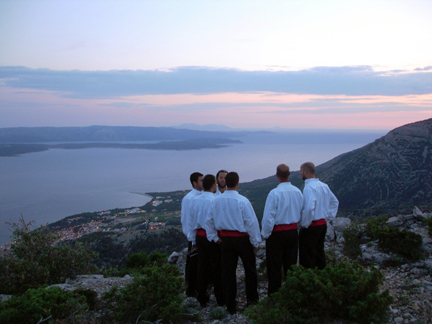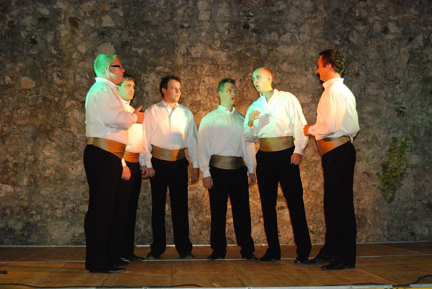Klapa singing is a multipart singing phenomenon of the urban Dalmatia. Originally, the term refers to the singing groups (4-10 male singers - klapa) that sing specific repertoire of Dalmatian klapa songs (klapska pjesma). The term “klapa” appeared in the mid-19th century in Dalmatia, initially denoting a group of friends. About the same time, group singing appeared to be later associated with the term.
The leader of the singing group is the highest voice - I. tenor, followed by several II. tenori, baritoni and basi voices. Multipart singing, a capella homophonic singing, oral tradition and simple music making are the main features of traditional klapa singing. Another important feature of the klapa is the ability to sing freely, without the help of the notation of tunes and their harmonisation. During the performance, singers stand in the recognizable setup, tight semi-circle, communicating occasionally by the hand gestures and moves of the singing leader - I. tenor. I. tenor starts the singing followed by the others in a specific manner (singing formulas) where II. tenori sing in parallel thirds, basi feature the major key functions and baritoni “fill” the harmony of the chords. Technically, klapa singers express their mood by means of open guttural, nasal, serenade-like sotto voce and falsetto singing, and usually in high-pitched tessitura. The main aim of the singers is to achieve the best possible blend of voices. Topics of klapa songs usually deal with love, familiar life situations, and the environment in which they live. Love, though, is the predominant theme.
Klapa multipart singing of Dalmatia, southern Croatia - UNESCO Intangible Cultural Heritage
 Dalmatian klapa group singing - island of Brač, Dalmatia, 2005. Zdenka Krunić
Dalmatian klapa group singing - island of Brač, Dalmatia, 2005. Zdenka Krunić
© 2011 by Ministry of Culture

Dalmatian klapa group singing - summer concert, island of Brač, Dalmatia, 2004. Ivana Bošković Ivičić
© 2011 by Ministry of Culture

Dalmatian klapa group singing at one of klapa festivals 2009. Ante Poljak
© 2011 by Ministry of Culture
|
 Dalmatian klapa group singing at Omiš Festival 2009. Croatian Klapa Association
Dalmatian klapa group singing at Omiš Festival 2009. Croatian Klapa Association
© 2011 by Ministry of Culture





